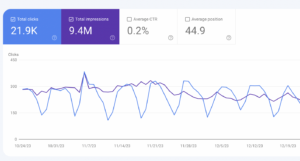When it comes to Google, change is inevitable. With the belief that “there’s always more information out there,” Google is constantly trying to stay up-to-date with new trends and technologies. The challenge businesses face with this philosophy is finding a way to keep up with the updates to Google algorithms and how they affect SEO practices. The way businesses create SEO strategies largely relies on the guidelines and algorithms Google has in place, so it’s vital to know what’s happening within Google.
A Timeline of Google Algorithm Changes
Since there are plenty of updates out there to keep track of, we’ve decided to make the task a little easier for you. Below is a brief timeline of all the major updates to Google algorithms that have impacted SEO over the years.
Florida
In November 2003, Google rolled out the first of many algorithm updates. Dubbed “Florida” for how it hit SEO practices like a hurricane, changing the way Search Engine Results Pages (SERPs) appeared across the board. Gone were the days of keyword stuffing in an attempt to rank higher. Common 1990s SEO practices like hidden links were tossed aside in place of new tactics Google was beginning to implement. The Florida Google algorithm update caused a shift toward the idea of creating higher-quality sites that contained relevant content compared to the initial query. Florida paved the way for what we now know as Google’s Webmaster Guidelines.
Panda
The year 2011 brought about a Google algorithm change that targeted sites with thin content. Known as Panda, this update was meant to reward websites that created high-quality content and penalize those that violated guidelines. Panda detected the quality of a site based on Google’s quality guidelines and determined whether the content answered the query. By bringing these higher-quality sites to the forefront of SERPs, users were able to find content that better matched their search intent.
Penguin
In an effort to continue to reward high-quality sites, Google introduced an algorithm that worked hand-in-hand with Panda. The Penguin update made its first appearance in April of 2012 and continues to leave its mark on SEO for years to come. Before the Penguin update, link volume played a massive role in ranking. The more links you had, the higher your page might rank. With this algorithm change, black hat linking became a huge red flag. As Google crawled and indexed pages, the Penguin update began to pick up on elements like hidden text and ranked pages accordingly.
Exact Domain Match
In line with the Panda and Penguin updates, Google rolled out one more algorithm update in 2012 that focused on low-quality websites. Before 2012, Google ranked pages with exact domain matches higher in terms of SEO despite the content being produced. With the Exact Domain Match algorithm update, that practice all but ended. Instead of ranking pages based on exact domain or keyword matches, Google began to look closer at the content on these matches to determine ranking status. Exact Match Domain continued the fight in keeping sites accountable for creating high-quality content that actually answered a user’s query intent.
Hummingbird
Google’s algorithm update in 2013, known as Hummingbird, changed the way queries could be understood. Instead of exact matches appearing on SERPs, conversational search became the new norm. Hummingbird focused on using everyday language, synonyms, and common themes to decide what pages to show a user. The ability to use keyword variations became accessible to the public. Through the change in Hummingbird, Google was finally able to better match a user’s intent to the pages being shown.
Pigeon
Google algorithms saw a major change in 2014 with the release of the Pigeon update. With this update, local businesses saw their sites ranking more than ever. Local businesses with a strong organic presence were rewarded for their SEO efforts. New and improved SERPs were making their way into the world with the introduction of Pigeon as well. Local packs switched from showing users seven-plus businesses to highlighting the top three. SERPs became more cohesive, particularly with local businesses, to improve user experience.
Mobilegeddon
These days, it seems like everything is focused on mobile-friendly experiences. Restaurants are making their menus digital, social media is booming more than ever, and Google algorithms are no exception. The focus on mobile usability occurred back in 2015 with the release of the Mobilegeddon update. Suddenly, the mobile usability of a site was a priority among the ranking signals, and many businesses began to lean toward mobile-first designs. Google set clear guidelines on what a mobile-friendly site should look like, leaving no room for deception.
Although Google is still making updates as we speak, this list covers some of the major changes that will help you along the way with your SEO strategy. Looking for some help? Markitors is an SEO agency fluent in all things Google algorithms. Contact us to learn more about how you can optimize your site using Google’s guidelines and gain more leads.







